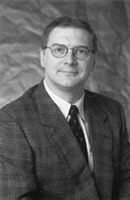
American Psychologist
Influences
- Student of: Lloyd Humphreys
- Influenced by: Benbow, Terman
- Students:
- Influenced:
- Time Period: Current Efforts
Education
- University of Minnesota, BA summa cum laude in Psychology (1981); Ph.D. in Psychology (1987)
- University of Illinois, Champaign-Urbana, Quantitative Methods Training Program, Department of Psychology, Postdoctoral Fellow (1987-1990)
Career
- Iowa State University, Department of Psychology, Assistant Professor (1990-1994); Associate Professor (1994-1998)
- Co-Director, Study of Mathematically Precocious Youth (SMPY) (1991- present)
- Director, Psychometrics and Applied Individual Differences (PAID) Division, Department of Psychology, Iowa State University (1994-1998)
- Vanderbilt University, Department of Psychology and Human Development, Associate Professor (1998-2001); Professor (2001- present)
- Director of Graduate Studies, Department of Psychology and Human Development, Vanderbilt University (1999-2003)
- Numerous awards, including: Mensa Awards for Research Excellence (1990, 1991, 1993, 1999, 2002, 2003); American Educational Research Association Research Excellence Award, Division E (1995); George A. Miller Award of the American Psychological Association (APA) (1996); Distinguished Scientific Award for Early Career Contribution to Psychology, APA (1996); Templeton Award for Positive Psychology (2000); Top 5% Productivity Rating Among Developmental Science Faculty, Developmental Review, 21 (2001); James McKeen Cattell Sabbatical Award (2003-2004)
Definition of Intelligence
“…[T]he models I’ve found most useful are the models by Jack Carroll and Dick Snow…They actually build on decades of psychometric research to build a hierarchical model of intelligence. It has a general factor at its summit…that accounts for approximately half of the variation in individual differences in human intellectual functions, and people name that function differently. Some talk about it as an intellectual sophistication function, general intelligence, g. They’re pretty much the same thing. And then there are specific abilities—specific factors—that are more molecular, that have to do with spatial reasoning, verbal reasoning, quantitative reasoning. And they go down to more molecular strands after that (personal communication, July 23, 2003)”.
Major Contributions
- Co-Director of the Study of Mathematically Precocious Youth (SMPY), a planned 50 year longitudinal study of highly gifted students
Click here to see the interview transcript and video clips
Ideas & Interests
David Lubinski’s many notable contributions to the field of human intelligence have focused on understanding individual differences among intellectually talented individuals. As co-director of the planned 50-year longitudinal Study of Mathematically Precocious Youth (SMPY), Dr. Lubinski has dedicated his career to exploring and optimizing the educational and vocational development of gifted students as they mature and make choices about how to navigate their lives.
A man of diverse interests and talents, Dr. Lubinski pursued a double major in experimental and counseling psychology in graduate school, which he followed with three years of postdoctoral training in quantitative methods. This particular skill set has proved an invaluable asset to the ambitious objectives of the SMPY.
The SMPY began in 1971, under the direction of psychologist Julian Stanley. Dr. Lubinski became co-director with psychologist Camilla Benbow in 1991. Its goal is to study the optimal development of intellectual talent over the lifespan. In addition to gathering information about the specific ability profiles of the participants, the SMPY is helping psychologists and educators to understand the values, personality patterns and educational and vocational preferences and outcomes of highly gifted individuals (see Wai, Lubinski, & Benbow, 2005). These data are useful for making recommendations for talent development and educational policy, e.g. special programs for gifted children, advanced placement classes and issues related to grade acceleration (Achter & Lubinski, 2003; Bleske-Rechek, Lubinski & Benbow, 2004). The study is now in its fourth decade of data collection, and as new participants are recruited, the original 1970s cohorts continue to be followed.
Some of Dr. Lubinski’s more recent research is focused on spatially-talented students, who demonstrate gifts in nonverbal ideation and visualization. He believes that these future architects, physical scientists and creative artists are underserved population, in part because their talents are not readily identified by assessment instruments used in many talent searches (Lubinski & Benbow, 2000; Shea, Lubinski, & Benbow, 2001).
Selected Publications
Benbow, C. P., & Lubinski, D. (1993). Psychological profiles of the mathematically talented: Some sex differences and evidence supporting their biological basis. In The origins and development of high ability. Ciba Foundation Symposium, 178 (pp. 44-66). Oxford: John Wiley & Sons.
Benbow, C. P., & Lubinski, D. (Eds.). (1996). Intellectual talent: Psychometric and social issues. Baltimore: Johns Hopkins University Press.
Bleske-Rechek, A., Lubinski, D, & Benbow, C. P. (2004). Meeting the educational needs of special populations: Advanced placement’s role in developing exceptional human capital. Psychological Science, 15(4), 217-224.
Lubinski, D., & Benbow, C. P. (1994). The study of mathematically precocious youth: The first three decades of a planned 50-year study of intellectual talent. In R. F.
Subotnik & K. D. Arnold (Eds). Beyond Terman: Contemporary longitudinal studies of giftedness and talent (pp. 255-281). Westport, CT: Ablex.
Lubinski, D., & Benbow, C. P. (2000). States of excellence. American Psychologist, 55(1), 137-150
References
Achter, J. A & Lubinski, D. (2003). Fostering exceptional development in intellectually talented populations. In W. B. Walsh (Ed.). Counseling psychology and optimal human functioning. Contemporary topics in vocational psychology. (pp. 25-54). Mahwah, NJ, US: Lawrence Erlbaum.
Bleske-Rechek, A., Lubinski, D, & Benbow, C. P. (2004). Meeting the educational needs of special populations: Advanced placement’s role in developing exceptional human capital. Psychological Science, 15(4), 217-224.
Lubinski, D., & Benbow, C. P. (2000). States of excellence. American Psychologist, 55(1), 137-150
Shea, D. L., Lubinksi, D., & Benbow, C. P. (2001). Importance of assessing spatial ability in intellectually talented young adolescents: A 20-year longitudinal study. Journal of Educational Psychology, 93(3), 604-614.
Wai, J., Lubinski, D., & Benbow, C. P. (2005). Creativity and occupational accomplishments among intellectually precocious youths: An age 13 to age 33 longitudinal study. Journal of Educational Psychology, 97(3), 484-492.
Image Courtesy of David Lubinski
